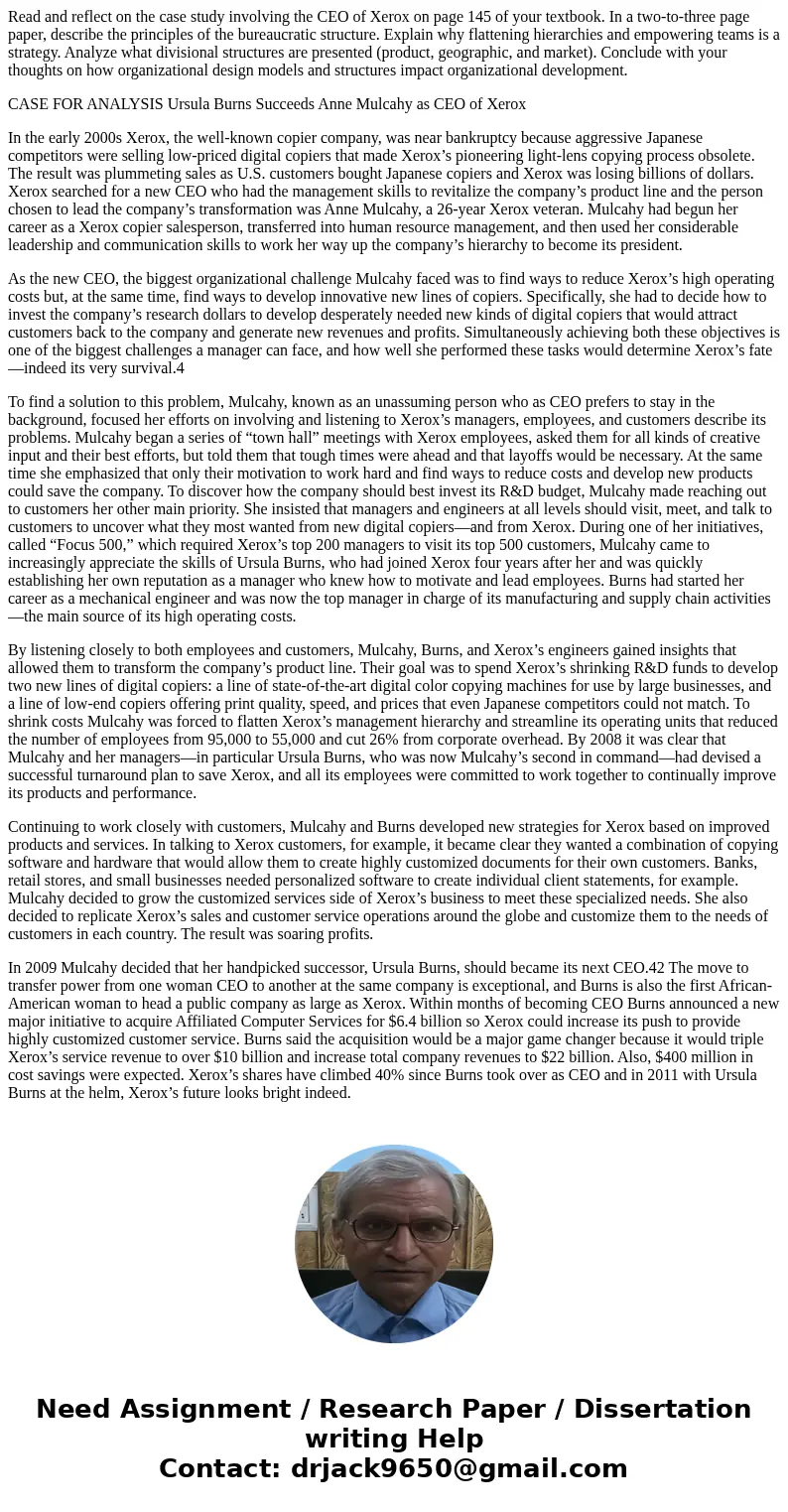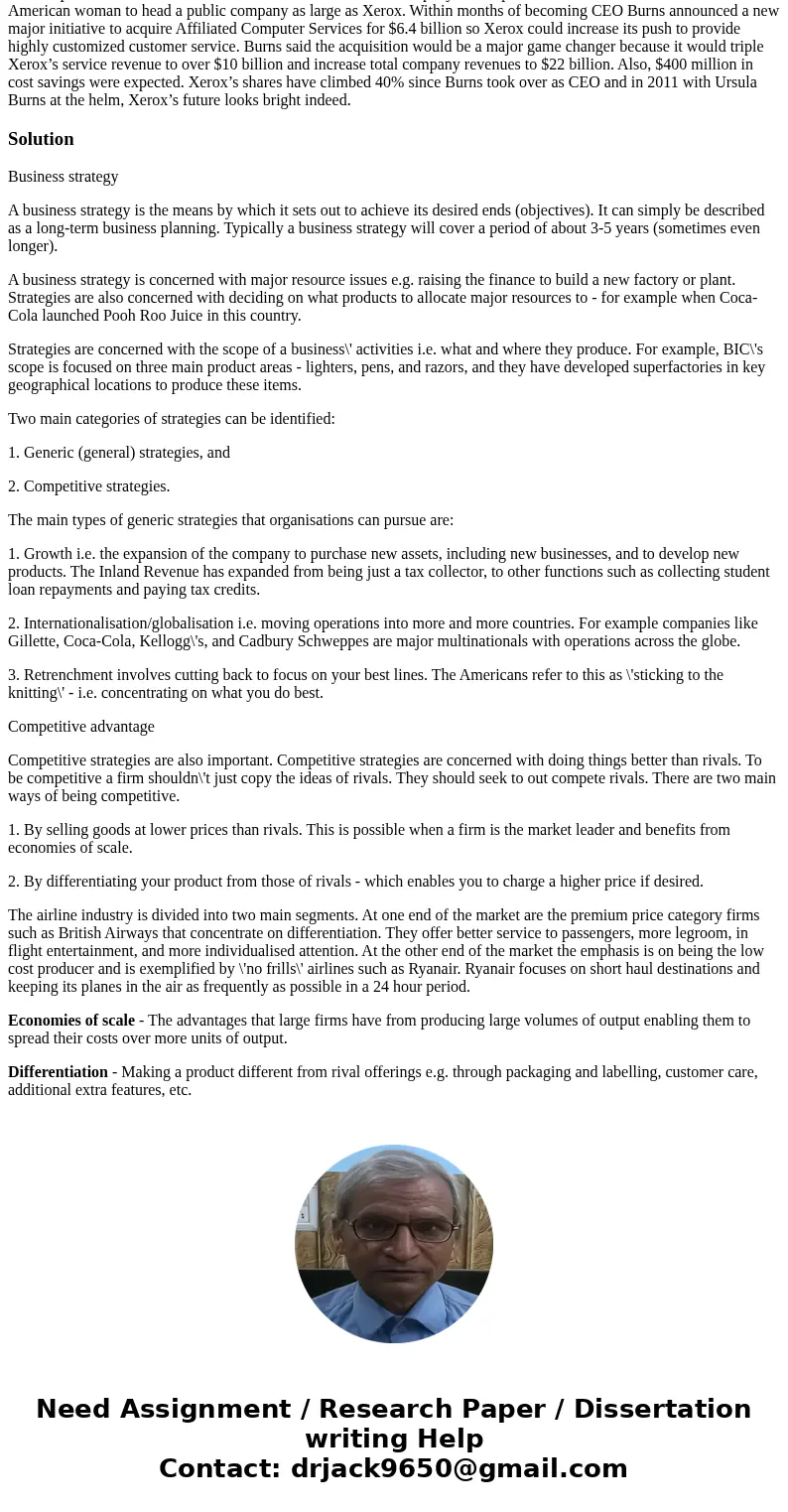Read and reflect on the case study involving the CEO of Xero
Read and reflect on the case study involving the CEO of Xerox on page 145 of your textbook. In a two-to-three page paper, describe the principles of the bureaucratic structure. Explain why flattening hierarchies and empowering teams is a strategy. Analyze what divisional structures are presented (product, geographic, and market). Conclude with your thoughts on how organizational design models and structures impact organizational development.
CASE FOR ANALYSIS Ursula Burns Succeeds Anne Mulcahy as CEO of Xerox
In the early 2000s Xerox, the well-known copier company, was near bankruptcy because aggressive Japanese competitors were selling low-priced digital copiers that made Xerox’s pioneering light-lens copying process obsolete. The result was plummeting sales as U.S. customers bought Japanese copiers and Xerox was losing billions of dollars. Xerox searched for a new CEO who had the management skills to revitalize the company’s product line and the person chosen to lead the company’s transformation was Anne Mulcahy, a 26-year Xerox veteran. Mulcahy had begun her career as a Xerox copier salesperson, transferred into human resource management, and then used her considerable leadership and communication skills to work her way up the company’s hierarchy to become its president.
As the new CEO, the biggest organizational challenge Mulcahy faced was to find ways to reduce Xerox’s high operating costs but, at the same time, find ways to develop innovative new lines of copiers. Specifically, she had to decide how to invest the company’s research dollars to develop desperately needed new kinds of digital copiers that would attract customers back to the company and generate new revenues and profits. Simultaneously achieving both these objectives is one of the biggest challenges a manager can face, and how well she performed these tasks would determine Xerox’s fate—indeed its very survival.4
To find a solution to this problem, Mulcahy, known as an unassuming person who as CEO prefers to stay in the background, focused her efforts on involving and listening to Xerox’s managers, employees, and customers describe its problems. Mulcahy began a series of “town hall” meetings with Xerox employees, asked them for all kinds of creative input and their best efforts, but told them that tough times were ahead and that layoffs would be necessary. At the same time she emphasized that only their motivation to work hard and find ways to reduce costs and develop new products could save the company. To discover how the company should best invest its R&D budget, Mulcahy made reaching out to customers her other main priority. She insisted that managers and engineers at all levels should visit, meet, and talk to customers to uncover what they most wanted from new digital copiers—and from Xerox. During one of her initiatives, called “Focus 500,” which required Xerox’s top 200 managers to visit its top 500 customers, Mulcahy came to increasingly appreciate the skills of Ursula Burns, who had joined Xerox four years after her and was quickly establishing her own reputation as a manager who knew how to motivate and lead employees. Burns had started her career as a mechanical engineer and was now the top manager in charge of its manufacturing and supply chain activities—the main source of its high operating costs.
By listening closely to both employees and customers, Mulcahy, Burns, and Xerox’s engineers gained insights that allowed them to transform the company’s product line. Their goal was to spend Xerox’s shrinking R&D funds to develop two new lines of digital copiers: a line of state-of-the-art digital color copying machines for use by large businesses, and a line of low-end copiers offering print quality, speed, and prices that even Japanese competitors could not match. To shrink costs Mulcahy was forced to flatten Xerox’s management hierarchy and streamline its operating units that reduced the number of employees from 95,000 to 55,000 and cut 26% from corporate overhead. By 2008 it was clear that Mulcahy and her managers—in particular Ursula Burns, who was now Mulcahy’s second in command—had devised a successful turnaround plan to save Xerox, and all its employees were committed to work together to continually improve its products and performance.
Continuing to work closely with customers, Mulcahy and Burns developed new strategies for Xerox based on improved products and services. In talking to Xerox customers, for example, it became clear they wanted a combination of copying software and hardware that would allow them to create highly customized documents for their own customers. Banks, retail stores, and small businesses needed personalized software to create individual client statements, for example. Mulcahy decided to grow the customized services side of Xerox’s business to meet these specialized needs. She also decided to replicate Xerox’s sales and customer service operations around the globe and customize them to the needs of customers in each country. The result was soaring profits.
In 2009 Mulcahy decided that her handpicked successor, Ursula Burns, should became its next CEO.42 The move to transfer power from one woman CEO to another at the same company is exceptional, and Burns is also the first African-American woman to head a public company as large as Xerox. Within months of becoming CEO Burns announced a new major initiative to acquire Affiliated Computer Services for $6.4 billion so Xerox could increase its push to provide highly customized customer service. Burns said the acquisition would be a major game changer because it would triple Xerox’s service revenue to over $10 billion and increase total company revenues to $22 billion. Also, $400 million in cost savings were expected. Xerox’s shares have climbed 40% since Burns took over as CEO and in 2011 with Ursula Burns at the helm, Xerox’s future looks bright indeed.
Solution
Business strategy
A business strategy is the means by which it sets out to achieve its desired ends (objectives). It can simply be described as a long-term business planning. Typically a business strategy will cover a period of about 3-5 years (sometimes even longer).
A business strategy is concerned with major resource issues e.g. raising the finance to build a new factory or plant. Strategies are also concerned with deciding on what products to allocate major resources to - for example when Coca-Cola launched Pooh Roo Juice in this country.
Strategies are concerned with the scope of a business\' activities i.e. what and where they produce. For example, BIC\'s scope is focused on three main product areas - lighters, pens, and razors, and they have developed superfactories in key geographical locations to produce these items.
Two main categories of strategies can be identified:
1. Generic (general) strategies, and
2. Competitive strategies.
The main types of generic strategies that organisations can pursue are:
1. Growth i.e. the expansion of the company to purchase new assets, including new businesses, and to develop new products. The Inland Revenue has expanded from being just a tax collector, to other functions such as collecting student loan repayments and paying tax credits.
2. Internationalisation/globalisation i.e. moving operations into more and more countries. For example companies like Gillette, Coca-Cola, Kellogg\'s, and Cadbury Schweppes are major multinationals with operations across the globe.
3. Retrenchment involves cutting back to focus on your best lines. The Americans refer to this as \'sticking to the knitting\' - i.e. concentrating on what you do best.
Competitive advantage
Competitive strategies are also important. Competitive strategies are concerned with doing things better than rivals. To be competitive a firm shouldn\'t just copy the ideas of rivals. They should seek to out compete rivals. There are two main ways of being competitive.
1. By selling goods at lower prices than rivals. This is possible when a firm is the market leader and benefits from economies of scale.
2. By differentiating your product from those of rivals - which enables you to charge a higher price if desired.
The airline industry is divided into two main segments. At one end of the market are the premium price category firms such as British Airways that concentrate on differentiation. They offer better service to passengers, more legroom, in flight entertainment, and more individualised attention. At the other end of the market the emphasis is on being the low cost producer and is exemplified by \'no frills\' airlines such as Ryanair. Ryanair focuses on short haul destinations and keeping its planes in the air as frequently as possible in a 24 hour period.
Economies of scale - The advantages that large firms have from producing large volumes of output enabling them to spread their costs over more units of output.
Differentiation - Making a product different from rival offerings e.g. through packaging and labelling, customer care, additional extra features, etc.


 Homework Sourse
Homework Sourse